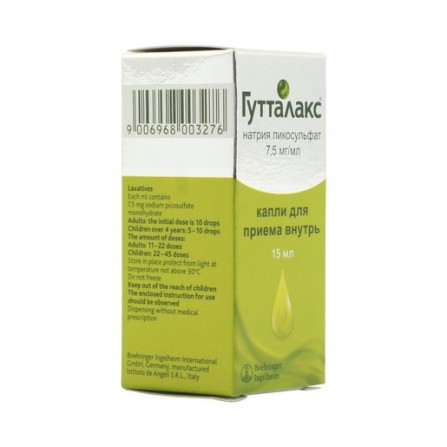Guttalax drops for oral administration 15 ml
Condition: New product
1000 Items
Rating:
Be the first to write a review!

More info
Active ingredients
Sodium picosulphate
Release form
Drops
Composition
100 ml of the preparation contains: Active substance: sodium picosulfate monohydrate 0.75 g. Excipients: sodium benzoate 0.20 g; sodium citrate dihydrate 0.15 g; sorbitol liquid (non-crystallizing) 64.37 g; citric acid monohydrate 0.14 g; purified water 49,89 g.
Pharmacological effect
Laxative drug. The active ingredient, sodium picosulfate, is a laxative of the triarylmethane group. As a local laxative, sodium picosulphate after bacterial cleavage in the large intestine has a stimulating effect on the mucous membrane of the colon, increasing the motility, contributes to the accumulation of water and electrolytes in the colon. This leads to the stimulation of the act of defecation, reducing the time of evacuation and softening of the chair.
Pharmacokinetics
After ingestion of sodium picosulfate enters the colon. The absorption of the drug is negligible, which excludes its enterohepatic circulation. In the colon, sodium picosulfate is cleaved to form the active metabolite, bis- (p-hydroxyphenyl) -pyridyl-2-methane. The development time of the laxative effect of the drug is determined by the rate of release of the active metabolite and is 6-12 hours. A small part of the drug enters the systemic circulation. The relationship between the laxative effect of the active metabolite and its concentration in serum is absent.
Indications
As a laxative in the following cases: - constipation caused by atony and hypotension of the colon (including in old age, in bedridden patients, after surgery, after childbirth and during lactation); - Constipation caused by taking medication; - to regulate the stool with hemorrhoids, proctitis, anal fissures (to soften the consistency of feces); - diseases of the gallbladder, irritable bowel syndrome with a predominance of constipation; - Constipation caused by intestinal dysbiosis, dietary disorders.
Contraindications
- intestinal obstruction; - obstructive bowel disease; - acute diseases of the abdominal organs or severe abdominal pain, which may be accompanied by nausea, vomiting, fever (including appendicitis); - acute inflammatory bowel disease; - severe dehydration; - fructose intolerance; - Hypersensitivity to sodium picosulfate and other components of the drug.
Precautionary measures
not described
Use during pregnancy and lactation
Data on reliable and well-controlled studies in pregnant women are not available. Long experience of use did not reveal the negative effect of the drug on pregnancy. Taking the drug in the first trimester of pregnancy is contraindicated. Studies on the effect of the drug on fertility were not conducted. In the course of preclinical studies, no teratogenic effects on reproduction have been identified.
Dosage and administration
Inside If not prescribed by a doctor, the following dosing regimen is recommended: Adults and children over 10 years old: 10-20 drops (5-10 mg) Children 4-10 years: 5-10 drops (2.5-5 mg) Recommended dose for children younger 4 years is 250 mcg / kg of body weight (this corresponds to 1 drop of the drug per 2 kg of body weight). To get a laxative effect in the morning hours, you should take the drug the night before. The drug does not necessarily dissolve in the liquid.
Side effects
On the part of the gastrointestinal tract, discomfort, nausea, vomiting, spasms and pain in the abdomen, diarrhea are possible. On the part of the nervous system, dizziness and fainting are possible. Dizziness and fainting that occurs after taking the drug may be associated with vasovagal reaction (for example, stress during defecation, abdominal cramps). Hypersensitivity reactions from the immune system are possible. Skin and subcutaneous tissues may cause skin reactions, for example, angioedema, skin rash, pruritus.
Overdose
Symptoms: when used in high doses, diarrhea, dehydration, decrease in blood pressure, impaired water and electrolyte balance, hypokalemia, convulsions are possible. In addition, there are reports of cases of ischemia of the muscles of the colon associated with taking the drug Guttalax in doses far exceeding those recommended for conventional treatment of constipation. Guttalax, like other laxatives, in chronic overdose can lead to chronic diarrhea, abdominal pain, hypokalemia, secondary hyperaldosteronism, urolithiasis. Due to the chronic abuse of laxatives, renal tubular damage, metabolic alkalosis and muscle weakness associated with hypokalemia may develop. Treatment: to reduce the absorption of the drug after ingestion, you can induce vomiting or gastric lavage.It may be necessary to replenish the fluid and correct the balance of electrolytes, as well as the appointment of antispasmodics.
Interaction with other drugs
With the simultaneous use of the drug Guttalax in high doses and diuretics or corticosteroids increases the risk of electrolyte disorders (hypokalemia). The simultaneous use of antibiotics can reduce the laxative effect of the drug Guttalax. Disruption of electrolyte balance may increase sensitivity to cardiac glycosides.
special instructions
Do not use the drug daily without consulting a doctor for more than 10 days. Prolonged use of high doses of the drug can lead to loss of fluid, electrolyte imbalance, hypokalemia. 1 ml of drops contains 0.45 g of sorbitol. The maximum recommended daily dose for the treatment of adults and children 4-10 years old contains 0.6 g and 0.3 g of sorbitol, respectively. The drug has no taste, so children can be added to food. Children should take the drug only on prescription.




